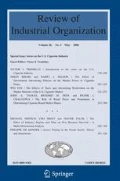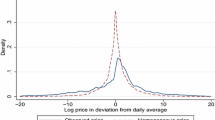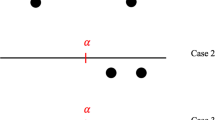Abstract
We examine search costs and product variety among multi-product retailers. Search costs may rise in variety, because consumers have more alternatives to consider, but may fall on the margin as product variety allows better matches between consumers and brands. We estimate a hierarchical model that disentangles the effect of variety on brand and store search costs. Our findings reveal that search costs within each store rise in product variety, suggesting that retailers reduce consumer search by offering deeper product assortments. But, the cost of searching among stores falls in product variety, which limits the exercise of market power.
Similar content being viewed by others
Notes
If unit search costs are constant (Mehta et al. 2003) then the total cost of searching rises linearly in the number of items offered. In the model below, consumers choose brands, but we measure variety by counting unique universal product codes (UPCs), which consists of many brand, size, flavor, and package combinations.
Point of Purchase Advertising International (2012) reports that 76 % of consumers’ purchases are the result of unplanned, in-store decisions; this is a feature that complicates price comparison across retailers.
While all search models are, by definition, multi-product, we use this term to differentiate search among single-product firms from search among multiple firms that each sell multiple products. We show below that this distinction is important.
A consideration set is the group of products that are actually evaluated for purchase, not just those on offer.
For simplicity, we drop the time index t.
Learning about prices may be important to the search process, but given that average prices for each brand do not differ across stores, and the coefficient of variation for brand-prices is 13.6 %, consumers can only learn about current price differences by searching on each visit. This form of learning is not, therefore, separately identifiable from search.
Conceptually, the store fixed-effects capture the effect of store size, location, cleanliness, quality of fresh produce, or ancillary services (Smith 2004) because our data do not describe any other attributes of the store. Note that the inclusive value term does not necessarily imply that consumers choose stores based solely on their cereal offerings, but this term is required by our GEV error assumption below.
Both of our focal stores are Hi-Lo stores.
In a grocery context, consumers purchase items by the shopping basket and not by the category (Russell and Petersen 2000; Kwak et al. 2015), but we assume that search activities are separable across categories. Intuitively, if search in one category does not inform the comparison in any other, single-category search models are valid.
A number of authors have shown that the manner in which consumers search is important. Weitzman (1979) and Stahl (1989, 1996) consider sequential processes for search, in which consumers search through products according to a rank-ordering of preference and select the first product that they discover that meets their tolerance level at an acceptable price. Kim et al. (2010) consider a sequential search process, in which search activity stops, and a choice is made, when a suitable product is found. De los Santos et al. (2012) compare sequential and non-sequential alternatives by exploiting a unique data set in which they observe consumers’ search processes, and find evidence to support the non-sequential model of search in an online retail context. Honka and Chintagunta (2016) estimate a mixture model that includes sequential and non-sequential components, and find that the non-sequential segment dominates the sequential segment. We design our model along the lines of this recent empirical evidence by framing consumer search with the use of a fixed-sample size rule.
The brands that are offered in all stores are the same, so the set of brands is the same in each store.
In the empirical model, no individual attributes were found to affect brand-search so they were excluded from the final model, but income was found to be important to store search costs.
In this model, our implicit assumption is that the \(IV_{j}\) term for the cereal category is positively correlated with the \(IV_{j}\) terms for other categories that are not included in our model as consumers are not likely to choose stores based only on their cereal offerings. In this model, the largest contributor to the ”other brands” option in both stores is the private label brand (or brands, given that they are aggregated in the IRI data). Given that the other brands are the same across both stores, any variation in the \(IV_{j}\) term is likely to be driven by differences in the private-label component of the model. If a retailer has a high-quality private label strategy, therefore, we expect it to be carried throughout the store as doing the opposite would be counter-productive. As a result, we would expect the \( IV_{j}\) term for the cereal category to be positively correlated with any \( IV_{j}\) term that we would estimate for any other category. In fact, in our data, the mean price for the private label brand in store 1 is $0.195/oz and is $0.172/oz in store 2, so this suggests that store 1 positions its store brand as a slightly higher-priced, and presumably higher-quality, alternative relative to the national brands.
Price pass-through from manufacturers to retailers in the cereal category is documented by Richards and Hamilton (2015).
For an application of these data that studies search costs in storable, non-food products, see Pires (2012).
We define a “brand” as a particular product-line from a given manufacturer. For example, all variants of General Mills Cheerios are defined as a single brand.
Market share in this table is defined as the conditional share of each brand in the cereal sales of each store. Estimation, however, uses the marginal share of each brand in the total Eau Claire cereal market, including both stores and all brands.
Of these other brands, the volume is dominated by private labels (62 % of other brand volume), which are reported as a single brand in the data.
Honka (2014) follows Chade and Smith (2006) who show that if the utility distributions of a set of products can be ranked according to a first-order stochastic dominance criteria, then calculating the expected utility from each choice, and ranking them accordingly, will describe a consumer’s simultaneous search process. A rule such as this is necessary in the absence of sequential search as described by Weitzman (1979). Vishwanath (1992) develops a ranking rule that is based on second-order stochastic dominance that uses reservation utilities instead of expected utilities. We follow Honka (2014) and rank cereals by their expected utility.
Note that Table 3 shows our sample to be older, less educated, and less likely to be single or non-white than the residents of Eau Claire county more generally. All of our results, therefore, are conditional on the nature of our sample.
The results from the first-stage model are as expected, but not presented here as they are not central to the brand-and-store search model. They are available from the authors upon request.
A brand is featured when it is advertised in the store’s weekly newspaper insert; it is on display when it appears in the store in a prominent location other than its usual shelf location, typically on an “end cap” or at the end of the aisle; it is on promotion when its price is temporarily reduced by 5 % or more (Bronnenberg et al. 2008).
We test for the endogeneity of prices, variety, and temporary price reductions using the control function method of Petrin and Train (2010). Using instruments that consist of all demographic variables, and prices, variety, and promotion variables from the other store (Hausman et al. 1994) we fail to reject exogeneity in each case.
Initial estimates of this model found household-attributes to be statistically insignificant, and we accordingly exclude household attributes from the final estimated version of the model.
We also estimate our pooled model with the use of a number of different sub-samples of the data: old (>55 years) and young (<55 years) sample members; large (>2.5 members) and small (<2.5 members) households; and high (>$55,000) and low (<$55,000 ) income. Our estimates of brand- and store-search costs do not change substantially from one sub-sample to the next. We conduct a likelihood-ratio (LR) Chow test for each of the model estimates and fail to reject the null hypothesis that the sub-sample parameter estimates are equal to the full-sample estimates in each case. In each case, the critical chi-square value with k degrees of freedom is 36.415, and the LR test statistics are, respectively, 1.758, 1.828, and 1.521, for the age-group, household-size, and income-level models.
Note that, as in Mehta et al. (2003), constant terms in the search-cost function are not separately identified from brand-preferences.
References
Anderson, S. P., & Renault, R. (1999). Pricing, product diversity, and search costs: A Bertrand–Chamberlin–Diamond model. The RAND Journal of Economics, 30(4), 719–735.
Anderson, S. P., & Renault, R. (2000). Consumer information and firm pricing: Negative externalities from improved information. International Economic Review, 41(3), 721–742.
Andrews, R. L., & Srinivasan, T. C. (1995). Studying consideration effects in empirical choice models using scanner panel data. Journal of Marketing Research, 32(1), 30–41.
Berry, S., Levinsohn, J., & Pakes, A. (1995). Automobile prices in market equilibrium. Econometrica, 63(4), 841–890.
Bhat, C. R. (2003). Simulation estimation of mixed discrete choice models using randomized and scrambled Halton sequences. Transportation Research Part B: Methodological, 37(9), 837–855.
Bakos, J. Y. (1997). Reducing buyer search costs: Implications for electronic marketplaces. Management Science, 43(12), 1676–1692.
Ben-Akiva, M., & Boccara, B. (1995). Discrete choice models with latent choice sets. International Journal of Research in Marketing, 12(1), 9–24.
Borle, S., Boatwright, P., Kadane, J. B., Nunes, J. C., & Galit, S. (2005). The effect of product assortment changes on customer retention. Marketing Science, 24(4), 616–622.
Briesch, R. A., Chintagunta, P. K., & Fox, E. J. (2009). How does assortment affect grocery store choice? Journal of Marketing Research, 46(2), 176–189.
Bronnenberg, B. J., Kruger, M. W., & Mela, C. F. (2008). Database paper—The IRI marketing data set. Marketing Science, 27(4), 745–748.
Brynjolfsson, E., & Smith, M. D. (2000). Frictionless commerce? A comparison of Internet and conventional retailers. Management Science, 46(4), 563–585.
Bucklin, R. E., & Lattin, J. M. (1991). A two-state model of purchase incidence and brand choice. Marketing Science, 10(1), 24–39.
Burdett, K., & Judd, K. L. (1983). Equilibrium price dispersion. Econometrica, 51(4), 955–969.
Cachon, G. P., Terwiesch, C., & Xu, Y. (2008). On the effects of consumer search and firm entry in a multiproduct competitive market. Marketing Science, 27(3), 461–473.
Cardell, N. S. (1997). Variance components structures for the extreme-value and logistic distributions with application to models of heterogeneity. Econometric Theory, 13(2), 185–213.
Chade, H., & Smith, L. (2006). Simultaneous search. Econometrica, 74(5), 1293–1307.
Chen, P. Y., & Hitt, L. (2003). Understanding price dispersion in internet-enabled markets. Working paper, Carnegie Mellon University, Pittsburgh, PA.
Clay, K., Krishnan, R., & Wolff, E. (2001). Prices and price dispersion on the web: Evidence from the online book industry. The Journal of Industrial Economics, 49(4), 521–539.
Cotterill, R. W. (1986). Market power in the retail food industry: Evidence from Vermont. The Review of Economics and Statistics, 68(3), 379–386.
Degeratu, A. M., Rangaswamy, A., & Wu, J. (2000). Consumer choice behavior in online and traditional supermarkets: The effects of brand name, price, and other search attributes. International Journal of research in Marketing, 17(1), 55–78.
De los Santos, B., Hortaçsu, A., & Wildenbeest, M. R. (2012). Testing models of consumer search using data on web browsing and purchasing behavior. The American Economic Review, 102(6), 2955–2980.
Dubé, J. P. (2004). Multiple discreteness and product differentiation: Demand for carbonated soft drinks. Marketing Science, 23(1), 66–81.
Dubé, J. P. (2005). Product differentiation and mergers in the carbonated soft drink industry. Journal of Economics & Management Strategy, 14(4), 879–904.
Haab, T. C., & Hicks, R. L. (1997). Accounting for choice set endogeneity in random utility models of recreation demand. Journal of Environmental Economics and Management, 34(2), 127–147.
Hausman, J., Leonard, G., & Zona, J. D. (1994). Competitive analysis with differenciated products. Annales d’Economie et de Statistique, 34, 159–180.
Heckman, J. J. (1991). Identifying the hand of past: Distinguishing state dependence from heterogeneity. The American Economic Review, 81(2), 75–79.
Hicks, R. L., & Schnier, K. E. (2010). Spatial regulations and endogenous consideration sets in fisheries. Resource and Energy Economics, 32(2), 117–134.
Hong, H., & Shum, M. (2006). Using price distributions to estimate search costs. The RAND Journal of Economics, 37(2), 257–275.
Honka, E. (2014). Quantifying search and switching costs in the US auto insurance industry. The RAND Journal of Economics, 45(4), 847–884.
Honka, E., & Chintagunta, P. K. (2016). Simultaneous or sequential? Search strategies in the US auto insurance industry. Search Strategies in the US Auto Insurance Industry. Retrieved from http://ssrn.com/abstract=2345449.
Iyengar, S. S., & Lepper, M. R. (2000). When choice is demotivating: Can one desire too much of a good thing? Journal of Personality and Social Psychology, 79(6), 995–1006.
Kim, J. B., Albuquerque, P., & Bronnenberg, B. J. (2010). Online demand under limited consumer search. Marketing Science, 29(6), 1001–1023.
Klemperer, P., & Padilla, A. J. (1997). Do firms’ product lines include too many varieties? The RAND Journal of Economics, 28(3), 472–488.
Koulayev, S. (2009). Estimating demand in search markets: The case of online hotel bookings. FRB of Boston working paper no. 09-16. Retrieved from http://ssrn.com/abstract=1523926.
Kuksov, D. (2004). Buyer search costs and endogenous product design. Marketing Science, 23(4), 490–499.
Kuksov, D., & Villas-Boas, J. M. (2010). When more alternatives lead to less choice. Marketing Science, 29(3), 507–524.
Kwak, K., Duvvuri, S. D., & Russell, G. J. (2015). An analysis of assortment choice in grocery retailing. Journal of Retailing, 91(1), 19–33.
Lattin, J. M., & Bucklin, R. E. (1989). Reference effects of price and promotion on brand choice behavior. Journal of Marketing Research, 26(3), 299–310.
Lehmann, D. R. (1998). Customer reactions to variety: Too much of a good thing? Journal of the Academy of Marketing Science, 26(1), 62–65.
Mehta, N., Rajiv, S., & Srinivasan, K. (2003). Price uncertainty and consumer search: A structural model of consideration set formation. Marketing Science, 22(1), 58–84.
Mojir, N., Sudhir, K., & Khwaja, A. (2016). Spatiotemporal search. Cowles Foundation discussion paper no. 1942. Retrieved from http://ssrn.com/abstract=2410349.
Moraga-González, J. L., & Wildenbeest, M. R. (2008). Maximum likelihood estimation of search costs. European Economic Review, 52(5), 820–848.
Moraga-González, J. L., Sándor, Z., & Wildenbeest, M. R. (2015). Consumer search and prices in the automobile market. IESE Business School working paper no. 1123-E; Kelley School of Business research paper no. 15-45. Retrieved from http://ssrn.com/abstract=2609338.
Nevo, A. (2001). Measuring market power in the ready-to-eat cereal industry. Econometrica, 69(2), 307–342.
Oppewal, H., & Koelemeijer, K. (2005). More choice is better: Effects of assortment size and composition on assortment evaluation. International Journal of Research in Marketing, 22(1), 45–60.
Petrin, A., & Train, K. (2010). A control function approach to endogeneity in consumer choice models. Journal of Marketing Research, 47(1), 3–13.
Pires, T. (2012). Consideration sets in storable goods markets. Working paper, Northwestern University, Evanston, IL.
Point of Purchase Advertising International. (2012). 2012 shopper engagement study media topline report.
Richards, T. J., & Hamilton, S. F. (2015). Variety pass-through: An examination of the ready-to-eat breakfast cereal market. Review of Economics and Statistics, 97(1), 166–180.
Roberts, J. H., & Lattin, J. M. (1991). Development and testing of a model of consideration set composition. Journal of Marketing Research, 28(4), 429–440.
Russell, G. J., & Petersen, A. (2000). Analysis of cross category dependence in market basket selection. Journal of Retailing, 76(3), 367–392.
Smith, H. (2004). Supermarket choice and supermarket competition in market equilibrium. The Review of Economic Studies, 71(1), 235–263.
Stahl, D. O. (1989). Oligopolistic pricing with sequential consumer search. The American Economic Review, 79(4), 700–712.
Stahl, D. O. (1996). Oligopolistic pricing with heterogeneous consumer search. International Journal of Industrial Organization, 14(2), 243–268.
Tappata, M. (2009). Rockets and feathers: Understanding asymmetric pricing. The RAND Journal of Economics, 40(4), 673–687.
Train, K. E. (2009). Discrete choice methods with simulation. Cambridge: Cambridge university press.
Train, K. E., & Winston, C. (2007). Vehicle choice behavior and the declining market share of US automakers. International Economic Review, 48(4), 1469–1496.
Trindade, A. (2015). Price and variety in supermarkets: Can store competition hurt consumers? Retrieved from http://ssrn.com/abstract=1878830.
Vishwanath, T. (1992). Parallel search for the best alternative. Economic Theory, 2(4), 495–507.
von Haefen, R. H. (2008). Latent consideration sets and continuous demand systems. Environmental and Resource Economics, 41(3), 363–379.
Weitzman, M. L. (1979). Optimal search for the best alternative. Econometrica, 47(3), 641–654.
Wildenbeest, M. R. (2011). An empirical model of search with vertically differentiated products. The RAND Journal of Economics, 42(4), 729–757.
Acknowledgments
Support from the Agriculture and Food Research Initiative (AFRI)—National Institute for Food and Agriculture (NIFA), USDA is gratefully acknowledged. The authors thank William Allender for his able research assistance.
Author information
Authors and Affiliations
Corresponding author
Rights and permissions
About this article
Cite this article
Richards, T.J., Hamilton, S.F. & Yonezawa, K. Variety and the Cost of Search in Supermarket Retailing. Rev Ind Organ 50, 263–285 (2017). https://doi.org/10.1007/s11151-016-9535-y
Published:
Issue Date:
DOI: https://doi.org/10.1007/s11151-016-9535-y




